Awards Ceremony, President's Day 2015 (Wednesday 3 June)
Prof David Manning, President opens proceedings.
Ladies and Gentlemen, Welcome to the Awards Ceremony.
It gives me particular pleasure to begin today with a word or two about the applied and industrial geology awards made by the Society through the year.
Some awards for applied work you will see presented later today.
However, there are others, including three highly prestigious industry awards made by the Society’s specialist groups.
The Petroleum Group Medal this year will be presented to Professor Al Fraser of Imperial College, London and formerly British Petroleum; while the Engineering Group’s 15th Glossop Medal was won by Mike Sweeney (lately of BP Upstream Technical Authority Geotechnics). The 18th Glossop Award went to young engineering geologist Joshua Morland of Atkins, for his work on the Cooper’s Hill Landslide.
These medals are in no way inferior to those awarded by Council’s Awards Committee, and I think their winners fully deserve to receive the first round of applause for today.
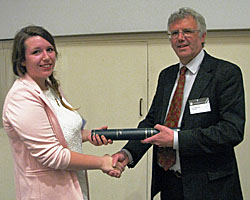 We begin the Society’s Awards Ceremony with one that encourages the next generation of applied geologists, following in the footsteps of William Smith, whose reputation we revere (especially this year, which marks the 200th birthday of his famous map) but who was not, himself, a Fellow. (He was however the first Wollaston Medallist – of which more anon.)
We begin the Society’s Awards Ceremony with one that encourages the next generation of applied geologists, following in the footsteps of William Smith, whose reputation we revere (especially this year, which marks the 200th birthday of his famous map) but who was not, himself, a Fellow. (He was however the first Wollaston Medallist – of which more anon.)
The Neil Duncan Award is a Bursary given by this Society to a student at Portsmouth University. Neil Duncan is a Senior Fellow who was responsible for starting the renowned Engineering Geology & Geotechnics Course at Portsmouth in 1967.
The Portsmouth Department makes this award in honour of that achievement, which this year goes to Ms Hollie Colville.
Anyone who has ever been President of anything will know that you are kept on a tight rein most of time. But we begin today with two Awards that are entirely in my gift!
Having said that, of course, I seek advice from people who can recognise rare promise when they see it; but the final choices are all mine. Which is why these are called the ‘President’s Awards’.
Samantha Engwell (President’s Award)
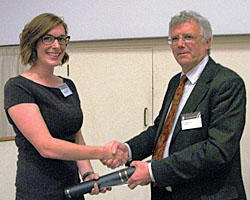 The first President’s Award today goes to Dr Samantha Engwell of the Istituto Nazionale di Geofisica e Vulcanologia, in Pisa.
Samantha Engwell is a field volcanologist with experience in applying statistical and numerical methods to understanding the processes associated with explosive volcanic eruptions. Her publications have focused on numerical modelling of pyroclastic density currents and coignimbrite plumes; estimating tephra volumes; producing objective isopach maps. She has studied ash layers in the deep-sea realm, as well as the effect of winds and other atmospheric factors and conditions upon the eruptive style of explosive volcanoes.
The first President’s Award today goes to Dr Samantha Engwell of the Istituto Nazionale di Geofisica e Vulcanologia, in Pisa.
Samantha Engwell is a field volcanologist with experience in applying statistical and numerical methods to understanding the processes associated with explosive volcanic eruptions. Her publications have focused on numerical modelling of pyroclastic density currents and coignimbrite plumes; estimating tephra volumes; producing objective isopach maps. She has studied ash layers in the deep-sea realm, as well as the effect of winds and other atmospheric factors and conditions upon the eruptive style of explosive volcanoes.
It may come as no surprise to those with even passing acquaintance with this field that, after graduating with first class honours from the University of Edinburgh, she studied for an MSc by research at Bristol University - where she also obtained her PhD, under the supervision of Professors Steve Sparks and Willy Aspinall. Since obtaining her doctorate in 2013 she has held a position as Marie Curie Early Stage Researcher at the Italian National Institute for Geophysics and Volcanology in Pisa.
Ladies and gentlemen, Samantha Engwell.
Steven Hollis (President’s Award)
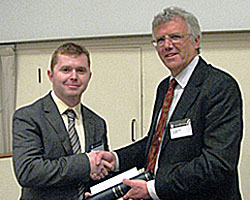 The second President’s Award goes to Dr Steven Hollis of CSIRO Mineral Resources Flagship, Australia. Steven graduated from Birmingham in 2007 with an MSci and then took an MSc in geochemistry in Leeds University in 2008. His PhD research was undertaken at Southampton University, on the evolution and mineralisation of volcanic arc sequences in the Tyrone Igneous Complex of Northern Ireland.
The second President’s Award goes to Dr Steven Hollis of CSIRO Mineral Resources Flagship, Australia. Steven graduated from Birmingham in 2007 with an MSci and then took an MSc in geochemistry in Leeds University in 2008. His PhD research was undertaken at Southampton University, on the evolution and mineralisation of volcanic arc sequences in the Tyrone Igneous Complex of Northern Ireland.
His presentations at national research meetings have earned him several commendations for oral and poster presentations. His doctoral research has made a substantive contribution to our understanding of the Tyrone Igneous Complex, confirming its correlation with the mineral-rich Buchans-Robert’s Arm arc-system of Newfoundland, with great potential significance for mineral exploration in the Province. He has also made a significant contribution to our understanding of the tectonic evolution of linear orogens. His current postdoctoral research focuses on volcanic massive sulphide mineralisation in the Archean Yilgarn Craton.
Ladies and gentlemen, Steven Hollis.
We now come to the Funds of the Society.
Sarah Bradley (William Smith Fund)
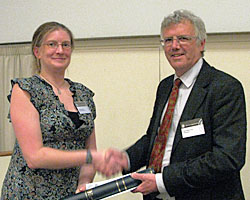 The William Smith Fund goes this year to Dr Sarah Bradley, of Utrecht University.
The William Smith Fund goes this year to Dr Sarah Bradley, of Utrecht University.
In a series of key papers published during and since her PhD, Sarah Bradley has contributed significantly to a new generation of numerical glacio-eustatic adjustment models, which integrate eustatic and isostatic processes in order to predict the deflection of the Earth’s surface when it is loaded and unloaded by ice and water. Using the latest findings from glacial geology and the rheology of the lithosphere and Upper Mantle, Sarah has been responsible for constraining the models that she has developed through her deep numerical expertise.
Such models have profound Earth-system implications, relating as they do to ice-sheet dynamics, sea-level change, climate and even archaeology. They are used, for example, in the latest UK Climate Impacts Projections, and provide the background isostatic adjustment required for assessing the vertical crustal-motion component contributing to rates of change in relative sea-level.
Sarah Bradley – for producing work of key relevance to our understanding of the Earth system – and within a decade of gaining your first Earth science degree - please accept now the William Smith Fund of The Geological Society of London.
Sebastian Watt (Murchison Fund)
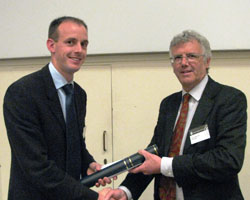 The Murchison Fund of the Society is awarded to Sebastian Watt of the University of Birmingham.
The Murchison Fund of the Society is awarded to Sebastian Watt of the University of Birmingham.
Despite having completed his PhD only four years ago, Sebastian Watt has already established a formidable reputation thanks to his considerable contributions in volcanology. These have included valuable additions to our understanding of how volcanic tephra disperses; reconstructing regional eruption histories, and furthering our knowledge of volcanic landslides and their consequences. His most significant work to date has been on the dispersal of ash from the 2008 eruption of Chaiten, which yielded the most complete observations of distal ash dispersion since the 1980 Mount St Helens eruption.
With a publication record of over 25 papers, he is highly proactive and his research interests are wide-ranging. He has already been awarded an NERC Postdoctoral Fellowship, and garnered an EGU Outstanding Young Scientist Award in 2014. The hallmarks of insight, thoroughness and scholarship can be found on all his work, and will ensure that his contributions are long-lasting in their influence.
Sebastian Watt, you are by any measure one of the leading young volcanologists in the world, and we are therefore pleased to award you today the Murchison Fund of The Geological Society of London.
Esther Sumner (Lyell Fund)
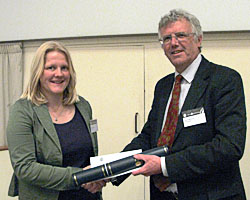 The Lyell Fund of the Society is awarded this year to Dr Esther Sumner of the University of Southampton.
The Lyell Fund of the Society is awarded this year to Dr Esther Sumner of the University of Southampton.
Esther Sumner has published a series of well regarded and highly cited papers containing major new insights into: turbidites as archives of earthquakes; the transition from turbulent to laminar sediment flows, and in monitoring active saline underflows from the Black Sea.
She brings a rare combination of experimental, observational and quantitative skills to her work. Her research into sediment-laden gravity flows combines physical and numerical modelling with direct observation of ancient and modern deep-water systems; including the direct monitoring of submarine gravity flows, analysing individual gravity-flow beds over distances in excess of a hundred kilometres and even - in the case of the modern Agadir Basin offshore Morocco - a thousand kilometres. Her analysis of recent turbidite and earthquake records from the Sumatran margin indicates that turbidites cannot be used simplistically as a proxy for palaeoseismicity – and so would be misleading if used to infer magnitude and recurrence intervals for hazard prediction and mitigation.
Esther Sumner, your contributions to date show high quality and distinction. Please accept therefore, with our congratulations, the Lyell Fund of The Geological Society of London.
Stefanie Hautmann (Wollaston Fund)
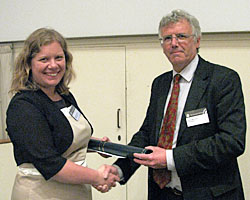 Stefanie Hautmann studies gravity and deformation with a view to better understanding volcano dynamics. Focusing on the Soufrière Hills Volcano, Montserrat, she has made a number of novel contributions.
Stefanie Hautmann studies gravity and deformation with a view to better understanding volcano dynamics. Focusing on the Soufrière Hills Volcano, Montserrat, she has made a number of novel contributions.
These have included the modelling of geodetic data to relate eruptive short-term cycles with elastic deformation along vertical sheet intrusions, to constrain the structure of the complex magmatic system and to document fluid pulses emanating from mid-crustal depths. This research resulted in novel insights into the process and timing of volcano degassing. She also was able to use gravity data to document fluid migration along major fault systems in response to volcanically induced changes in the stress field. She has also won grants from the National Geographic Society, the German National Academy of Sciences and the Swiss National Science Foundation.
Stefanie Hautmann, you are an enthusiastic, prolific, and highly talented young geophysicist, working outside your home country, who has produced a steady stream of insightful and original research papers with far-reaching implications for our understanding of how volcanoes work. In recognition of these early career achievements, we are delighted now to award you the Society’s Wollaston Fund for 2015.
Peter Loader (R H Worth Prize)
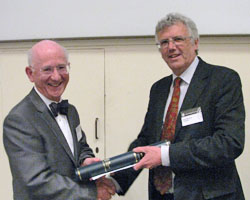 The R H Worth Prize celebrates the practice and encouragement of geological science by and among ‘amateurs’, a term we interpret broadly. This year we are pleased to award it to a distinguished teacher of geology, Peter Loader.
The R H Worth Prize celebrates the practice and encouragement of geological science by and among ‘amateurs’, a term we interpret broadly. This year we are pleased to award it to a distinguished teacher of geology, Peter Loader.
Peter retired last year as Geology Master at St Bede’s College, Manchester. He was able to look back on an unparalleled 38-career as a teacher of Earth Sciences, and on 20 years as Chief Examiner of the Welsh Joint Education Committee’s A-Level Geology specifications. From these positions of influence Peter has positively affected the lives and careers of many hundreds – I would guess thousands - of young geologists and has encouraged over 200 Bedian students to continue with geology at university.
Peter has always displayed a deep passion and commitment to the teaching of Earth science at all levels, as his work with the Society’s Education Committee and the Earth Science Teachers’ Association (of which he is now Chair) clearly demonstrates. Peter has been involved with ESTA which he joined in 1975, for all his professional life. And as well as being a regular contributor at conferences he is also a member of its Secondary Group and Reviews Editor for Teaching Earth Sciences.
His involvement with the Society’s Education Committee has been hands-on and practical, and he has co-written content for the website’s Education section and co-organised the ‘Geoscience Education Academy’, which provides continuing professional development to science teachers who are not Earth scientists. They, being the vast majority of science teachers, deliver the National Curriculum’s Earth science content to far more UK pupils than the few qualified geologist teachers ever could. Helping them to do this more effectively therefore brings a disproportionate benefit to geology.
Peter Loader, for these outstanding efforts, please accept, with our deepest admiration and respect, the R H Worth Prize of The Geological Society of London.
Peter Loader replied:
President, Fellows, Ladies and Gentlemen - I am, of course, delighted and honoured to accept this award even though my name is something of an anomaly on a list of such high academic achievers. Whilst my fellow award winners are busy probing the boundaries of our science, as an educator all I can do is to reflect their work in my teaching and examining.
Nevertheless, I am pleased to have played my part in promoting geology to my students, some of whom are Fellows of this institution, and producing relevant assessments for exam candidates. Like Adam Sedgwick my maxim has been “I can’t promise to teach you all geology, I can only fire your imaginations”.
To be an Earth science educator in these times is a challenge; not least in the pile of examination papers and coursework projects currently causing an isostatic imbalance in my study! Pressures from other subjects and the marginalisation of our own mean a constant battle to keep Earth science on the curriculum at all levels. On average over 40% of those currently studying in university Earth science departments have done A-level geology and we forget this supply line at our peril. It has been a privilege to have helped influence the uptake and direction of geology as an academic subject in secondary education, though the geological community, and in particular the Geological Society and ESTA, must take credit for driving this forward by supporting those, like me, tasked with developing new and relevant GCSE and A level specifications.
So perhaps it is appropriate for the Geological Society to honour an ordinary school teacher and I challenge my fellow award winners to answer one question; after all I am a Chief Examiner! What was the reason you got into geology in the first place? I am confident a number of you will cite some influential science, geography, or even a geology teacher that “fired your imaginations”.
And, looking around at the assembled gathering, I don’t think we did too bad a job!
Thank you.
John Catt (Distinguished Service Award)
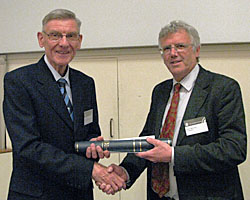 We come now to the Society’s Distinguished Service Award.
We come now to the Society’s Distinguished Service Award.
This year’s recipient, John Catt of University College London, moved from an academic background in Quaternary Geology into Pedology, working for the Rothamsted Experimental Station in Harpenden from 1963 to 1998 and acting as its Deputy Head. The success which he made of this transition can be judged by his career progression from ‘Scientific Officer’ to ‘Principal Scientific Officer’, and a publications list containing over 220 papers, books and book chapters published between 1961 and 2011.
John became and has remained an authority on soil genesis, mineralogy, chemistry, micromorphology and soil erosion, crop yields, leaching of nutrients and pesticides into surface waters – all while administering a large organisation, managing its staff, and maintaining an international reputation for his work on Quaternary glacial geology, palaeosols and their palaeoclimatic interpretation.
John has also worked tirelessly for greater professionalism among Earth scientists – initially through the Institution of Geologists prior to its merger with the Society, and subsequently on Council. He is a founder member of the Hertfordshire Geological Society, for which he has edited and contributed to the monumental Hertfordshire Geology and Landscape. He has also served on international bodies such as the International Union for Quaternary Research.
John, in recognition of this unconquerable enthusiasm and dedication, we are delighted to award you today the Distinguished Service Award of The Geological Society of London.
John Catt replied:
I feel very honoured today to receive the Society's Distinguished Service Award. Although trained in Geology at Hull University, 1957-1960, I was never much good at the sort of earth science most of today's audience would recognise as real geology - bedrock stratigraphy, petrology, palaeontology and the like. So it is very generous of the Society to acknowledge what I have done in term of the use of soils in palaeoclimatic reconstruction and Quaternary stratigraphy.
Studying in the Sixth Form at Grammar School in Kent, the Garden of England, I was originally attracted to soil science by a far-sighted schoolmaster, Frank Kenworthy. After completing a PhD at Hull on the Quaternary of East Yorkshire, this led me to Rothamsted, the oldest agricultural research station in the world, also at the time the headquarters of the Soil Survey of England and Wales.
Here I encountered such brilliant pioneering Soil Survey staff as Brian Avery, Don Mackney and Arthur Thomasson. In the 1960s they were developing a soil classification system based on multidisciplinary studies, mainly geology but also chemistry, soil physics, biology and climatic data. My own ideas on soils and Quaternary stratigraphy stem directly from them.
Mr President and fellow members, I accept this award, largely hiding behind the many other pseudo-geologists who, like myself, have used their fragmentary understanding of your science to advance other branches of Earth Science.
David Branagan (Sue Tyler Friedman Medal)
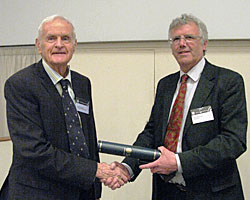 The Sue Tyler Friedman Medal, awarded for excellence in research into the history of geology, goes this year to Dr David Branagan of the University of Sydney.
The Sue Tyler Friedman Medal, awarded for excellence in research into the history of geology, goes this year to Dr David Branagan of the University of Sydney.
David approaches the history of geology and mining from the point of view of one who graduated in Geology from the University of Sydney in 1950. He then joined the Geological Survey of New South Wales and mapped Permian Coal Measures, as well as Lower Palaeozoic and Precambrian sequences. During this stage of his career he also became involved in engineering geology and while subsequently working as a Research Fellow at Sydney, specialising in coal and its utilisation, David was awarded his PhD in 1963 and went on to teach mining engineering geology, photogeology and field mapping for about 30 years, retiring in 1989 as Associate Professor of Geology. He thereafter continued his association with the University, becoming an Honorary Research Associate of Geology, History, and History & Philosophy of Science. He was Foundation editor of The Australian Geologist (1974-1984), President of INHIGEO (1992-1996), and was awarded an Honorary DSc by the University in 2007.
Of his 20 or so books and 230-odd papers and articles, about 130 have been dedicated to the history of geology and related sciences. This work includes numerous papers and books on famous Australian geologists and explorers J W Gregory, S Stutchbury, and many others. His book on T W Edgeworth David, published in 2005, recounting the life and career of this legendary Welsh-Australian geologist, Antarctic explorer, co-founder of the Australian Army Tunnelling Corps in World War One and inveterate campaigner for science on a global scale, has enjoyed a thoroughly deserved success, worldwide.
David Branagan, please accept with our deep respect and gratitude, the Sue Tyler Friedman Medal of The Geological Society of London.
David Branagan replied:
I am honoured to be the 2015 recipient of the Sue Tyler Friedman Award,
Today I am joining the ranks of numerous more distinguished historians of geology than myself, and to whom I owe much for their advice and friendship. I am the fourth Australian to have received this award, preceded by Tom Vallance, David Oldroyd and Homer le Grand, so the former colony has yielded perhaps unexpected value(s).!
It was my good fortune to have known Sue Tyler Friedman through her husband Gerald Friedman, to note their dedication to the history of Geology, and to have enjoyed their company at history conferences and excursions. This award is a tribute to their joint memory. Gerald will be remembered for his fine texts on sedimentary geology, and by the founding, and, I suspect, their joint funding of the journal, Earth Sciences History, of which he was the original editor; a journal which has built up an international reputation for its quality, through the continuing enthusiasm of its editors.
I have been lucky to have worked largely on Australian material, starting my interests when there were few researchers in the field, finding much basic information in Europe and the Americas. Through Tom Vallance, I met the pioneer couple, Joan and Victor Eyles, and became a contributor to the Australian Dictionary of Biography. It was Tom whose criticism ensured that the scientists who contributed considerably to Australia's development received due recognition in its pages.
There is still much history to be researched, and sadly, for many, it can only be a part-time effort. In recent years numerous superb publications tell us about the latest geology and geophysics. But the general reader might almost assume that the knowledge of the Earth came out of thin air. While some pioneers are relatively familiar names, other important, but less-remembered, persons deserve to be honoured.
Again, Mr President, I thank you, and those who nominated me for this considerable honour.
Stuart Archer (Aberconway Medal)
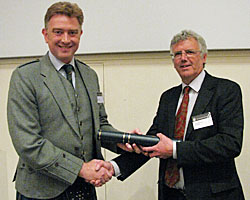 The Society’s Aberconway Medal, awarded for contributions to applied geology, goes this year to Dr Stuart Archer of Dana Petroleum.
The Society’s Aberconway Medal, awarded for contributions to applied geology, goes this year to Dr Stuart Archer of Dana Petroleum.
Stuart Archer’s work straddles the often challenging interface between industry and academe. Following a BSc at the University of Glasgow and a Master’s degree at the University of Aberdeen, he entered the oil business, working for ConocoPhillips for 12 years, covering a wide range of positions in exploration and production geology. Here he made a fundamental contribution to exploration efforts on the Atlantic Margin and also in the reservoir characterisation of fields in the Central North Sea, as well as broader studies of the Deepwater Palaeogene reservoir system in the Gulf of Mexico.
This work led to some seminal publications - notably on the geodynamic evolution and petroleum potential of the Rockall Trough, and in the Central North Sea on the Britannia Field, and the recent Jasmine discovery. He also completed a PhD in Aberdeen – an innovative study that developed methods in ‘geomorphic sequence stratigraphy’, as applied to river systems in the Basin and Range Province of the USA.
Then, in 2009 Stuart quit industry for his alma mater, becoming Director of the University of Aberdeen’s ‘exploHUB’ – a unique, immersive exploration training centre, reinvigorating regional hydrocarbon exploration and catering for staff from major international oil companies, national oil companies and oil service companies. ExploHUB’s success led to the development of a new MSc in Hydrocarbon Exploration and this is a tribute to Stuart’s enthusiasm, his clear commitment to teaching and sheer hard work.
Stuart has also served on the Petroleum Group Committee, as a committee member and then Secretary, taking responsibility for its public outreach activities, always willing to explain the importance of petroleum geoscience in delivering much-needed energy to the world.
The energy and passion that he has brought, coupled with his deep industry experience and willingness to collaborate across industrial / academic boundaries have made him a natural leader in world of petroleum geoscience.
Stuart Archer, you are a worthy recipient of the Aberconway Medal and it is my great pleasure to award it to you now.
Stuart Archer replied:
Good Afternoon President, learned Colleagues and Guests. It is a very great pleasure to be here in London at the Geological Society to be able to accept the Aberconway Medal.
Firstly, I’d like to take this opportunity to thank the Society for the strategic leadership role it performs in service of our geological community.
Thanks also go to the many industrial and academic colleagues who I have collaborated with over the years. Nothing that I have ever accomplished has been achieved in isolation and I am very fortunate to have worked in teams alongside some very talented geoscientists and engineers, who have been, equally importantly in my view, great people to be around.
I was introduced to geology in the late ‘80s by my high school geography teacher. Morton Fraser was a 6 foot tall, charismatic, old Highlander who wore a kilt to his work every day of his life. While never a professional geologist himself, he taught both physical geography and geology with great skill and flair. Thinking back, as these occasions allow you to do, it was the way Mr Fraser elegantly fused science and art that got me started – I was on the hook.
The encouragement I drew from this teacher and then later university lecturers was always a really important catalyst for me.
Once trained to postgraduate level at Aberdeen University, it was Phil Gardner and Phil Close at ConocoPhillips that convinced me it was time to get a real job. And so I joined an oil company (with some trepidation I might add) but was made to feel instantly welcome in the global geoscience meritocracy that is the oil and gas industry.
More recently it has been a great privilege to have supervised 12 PhD students and mentored 30 MSc students while I taught at Aberdeen University. Teaching in the class room (and in that invaluable outdoor classroom that we call the field), has been a source of great fulfilment for me.
In my current position in Dana Petroleum I’m greatly enjoying merging my previous industrial and academic experience to maximise the value of our asset base for KNOC, Dana’s Korean owner.
I’d like to close by looking to the future with positivity and a genuine belief that team work and collaboration will prevail where geoscience problem solving has role in applied geology. I believe that a stronger sense ‘of team’ between oil companies and more importantly between industry and the new oil and gas authority is needed in the North Sea today, arguably more than at any other time in its long history.
2015 is the 50th anniversary of first gas and the 40th anniversary of first oil from the North Sea, and the complexities that come with operating in a basin that in my view now needs to be classed as ultra-mature means we simply have to work together as TEAM NORTH SEA to get this right…………..the basin may be tired, but it’s not yet ready to be re-tired!
Ladies and Gentlemen, the great honour and privilege that I feel in accepting this award today will stay with me and my family as an afterglow of positivity for a very long time.
Thank you very much indeed
Alastair Robertson (Prestwich Medal)
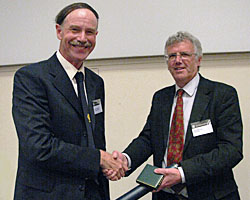 The Society’s Prestwich Medal goes this year to a geologist who has enjoyed a distinguished career and who continues to work at the forefront of tectonics and sedimentation: Professor Alastair Robertson.
Alastair has made outstanding contributions to our understanding of tectonics and sedimentation in, notably, the eastern Mediterranean, the Middle East and the Himalayas. His long-term involvement with ocean drilling has led to scientific advances not only in the geological evolution of the Mediterranean, but also the Atlantic and Pacific rims. His research output is, in all senses, prodigious – and all the more remarkable for having been produced alongside full teaching and examining duties, memberships of national and international committees, and supervising over 40 doctoral students.
The Society’s Prestwich Medal goes this year to a geologist who has enjoyed a distinguished career and who continues to work at the forefront of tectonics and sedimentation: Professor Alastair Robertson.
Alastair has made outstanding contributions to our understanding of tectonics and sedimentation in, notably, the eastern Mediterranean, the Middle East and the Himalayas. His long-term involvement with ocean drilling has led to scientific advances not only in the geological evolution of the Mediterranean, but also the Atlantic and Pacific rims. His research output is, in all senses, prodigious – and all the more remarkable for having been produced alongside full teaching and examining duties, memberships of national and international committees, and supervising over 40 doctoral students.
If there were an award for the ‘most prolific contributor to Geological Society publications’, we should probably have to award it to Alastair. His breadth is truly breath-taking. Although one could say that he worked on ‘Marine Studies, Stratigraphy and Tectonics’, such shorthand would hardly do justice to the way he has unravelled the histories of complex geological terrains, and (particularly in relation to ophiolites) the way he marshals such a wide range of diagnostic and investigative tools, and collaborates with geologists and research students from the countries in which he works, especially Turkey.
He is at heart a field geologist, and it is as though his underwater work grows from sheer frustration at not being able simply to go there and map. Alastair is also remarkable for his retentive and capacious memory, which allows him to move between such arcana as rare earth element patterns and radiolarian biostratigraphy, in a trice, and seemingly without effort.
Alastair Robertson, you are an outstanding geologist, applying numerous and varied tools to complex problems in a way that would have met with the thorough approval of Joseph Prestwich - whose medal I have great pleasure in conferring upon you today.
Alastair Robertson replied:
From his own work on the Tertiary of England, France and Belgium during the mid-19th Century, Joseph Prestwich clearly understood the ‘power’ of stratigraphy in field-based geology. A moment’s thought reminds us that stratigraphy remains at the heart of modern geology-think of the derivatives: lithostratigraphy, biostratigraphy, tectono-stratigraphy, seismic stratigraphy and so on. It is precisely because stratigraphical geology, which Joseph Prestwich pursued, remains so central to modern geology than I am delighted that the Society has decided to award me the Prestwich medal.
I am particularly pleased to follow in the footsteps of distinguished geologists, several of whom I have known personally. A very big thank you to all those who have helped me on my way, including my colleagues at the University of Edinburgh, those elsewhere in the UK and oversees, my current and previous post-graduate students, and especially my parents and my wife, Gillian.
The very generous citation includes reference to my interest in unravelling complex terranes, combining land and marine geology and collaboration with others here and abroad. This grew out of my boyhood interest in geology fuelled by mostly self-guided fieldtrips around Edinburgh and further afield. I learned early on that stratigraphical context is paramount and that you have to deal with the outcrops in front of you however inadequate and complex they may seem.
With time, I have become increasingly aware (sometime belatedly) of effective ways to research and I share several (hopefully positive) ones with you here: don’t stick with your favourite ‘ology’ but go for geological problem solving wherever this takes you; train your students (especially PhD students) to be more broadly based then you are yourself and position yourself, through collaboration, in the mainstream of international geoscience-a trunk stream is more powerful than a tributary.
Mr President, many thanks again for this medal.
Daniel Parsons (Bigsby Medal)
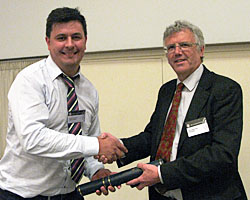 We come now to the Bigsby Medal, which this year is awarded to Professor Daniel Parsons of Hull University.
We come now to the Bigsby Medal, which this year is awarded to Professor Daniel Parsons of Hull University.
Professor Parsons is an internationally leading researcher in Process Sedimentology, and his work focuses on understanding process-product relationships through investigating the interaction of fluid-flows with mobile sediments. He does this by neatly coupling field measurements, laboratory modelling and numerical simulations.
His work on sediment dynamics, and in particular on bedforms, in deserts, in the world's largest rivers, in submarine channels in the deep ocean and on Planet Mars has resulted in a series of highly cited papers. Since 2011, he has led a series of projects within the state-of-the-art Total Environment Simulator facility at Hull University, a re-vitalised hub for hydraulic and process sedimentology experiments, and is now actively collaborating with over 20 universities in this country, the EU and the overseas on a range of research projects that are making use of this novel facility.
His dynamic and inclusive approach to science is perhaps best illustrated by the collaborative operation of the large flume tank experiments at the Total Environment Simulator since he was appointed to a personal chair at Hull, in 2011. Of the many research highlights that have come from this facility so far, we should mention: the first detailed measurements of the three-dimensional form of dune-related macroturbulence; simulations of scaled landforms produced by ancient catastrophic water outflows on Mars; assessment of the role of cohesive mud and biological materials in controlling sediment transport and bedforms in estuaries and coastal environments; river dune dynamics associated with flow-rate changes in floods; and his leadership of the Dynamic Humber Project, which examines the effects of natural and anthropogenic environmental change on the long-term state estuarine systems.
Daniel Parsons, for these and other many achievements, please accept today the Bigsby Medal of The Geological Society of London.
Rory Mortimore (Coke Medal)
We now come to the Society’s two Coke medals, awarded to geoscientists who have made a significant scientific contribution 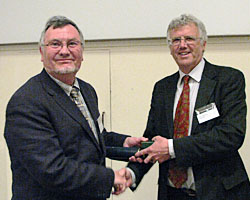 and been of significant service to geology through activities of benefit to the community.
The first goes to Professor Rory Mortimore of ChalkRock Ltd. Rory Mortimore’s career provides an exemplar of how to translate geological science into mainstream industrial activity. The way he applies pure geological research to resolving and avoiding problems in a number of fields means that few projects involving Cretaceous rocks, especially the Chalk, progress without the benefit of his advice.
and been of significant service to geology through activities of benefit to the community.
The first goes to Professor Rory Mortimore of ChalkRock Ltd. Rory Mortimore’s career provides an exemplar of how to translate geological science into mainstream industrial activity. The way he applies pure geological research to resolving and avoiding problems in a number of fields means that few projects involving Cretaceous rocks, especially the Chalk, progress without the benefit of his advice.
Widely sought by industry, he has prepared over 130 reports, providing understanding of ground conditions for civil engineering projects including: Southern Water tunnels, the Stonehenge Bypass, the Channel Tunnel and its rail link, CrossRail, and the Thames Tideway Tunnel. He has provided conceptual models for the water industry as the basis for numerical models used in such projects as the London Basin Aquifer Conceptual Model, and many more. He has also run workshops for the North Sea oil industry to aid their interpretation and management of Chalk oilfields.
His research has created an integrated understanding of the lithostratigraphy and complex engineering characteristics of the ‘White Chalk’, based on sound lithological description, and producing a traceable regional stratigraphy integrated with key, basin-wide biostratigraphical events. His combination of academic and practical knowledge has led the revision of Chalk Stratigraphy, designed to be relevant to lithostratigraphy, civil engineering and hydrogeology, and now to be found on BGS maps. It has led to greater understanding of tectonic events that continued through what was previously considered a tranquil phase of the Cretaceous. His enthusiasm to pass on this expertise, to civil engineers, the British Army, the Engineering Group and the largely amateur audience at his 2011 Shell London Lecture, has also made him one of geology’s foremost communicators.
Rory Mortimore, these achievements constitute highlights both of pure research and useful application - and render you a more than worthy recipient of the Coke Medal of The Geological Society of London.
Rory Mortimore replied:
Fellows of the Geological Society and friends – President it was a shock and delight to receive your letter. To receive one of the Coke Medals that honour two soldiers who died at the battle for Arnhem in the Second World War seems even more appropriate as my first career was with the British Army and, in later years, I was able to contribute to geological research programmes that the British Army undertook in Antarctica 2001-2003.
How I ended up working on the Chalk was pure serendipity.
Three key people were involved in helping me into this career. It would never have taken off if it had not been for Professor Michael House who gave me the chance to study geology at the University of Hull, after I came out of the army; my mother-in-law who contacted Dr Denis Henry in Civil Engineering at the then Brighton Polytechnic when my contract with the British Antarctic Survey (my first career after graduation) came to an end. Denis, a civil engineer with a passion for geology, took me on to investigate the geology and engineering behaviour of the Chalk for major construction projects.
Establishing a geological framework for such an investigation could not have been undertaken without team work and I thank the civil engineering community for their generosity in supporting the work from day one. I also thank the mapping teams at BGS who had the courage to remap the Chalk in England. Ideas have been tested, new geologies discovered and new technologies applied throughout the 40 years working with industry and this continues today with the offshore and onshore industry across Europe.
Lastly, I thank my co-director and wife Diana and my family. President, I accept this Coke Medal on behalf of the community of geologists and engineers who have supported me and made working on the Chalk such pleasure! This medal is the icing on the cake!
Sarah Davies (Coke Medal)
 The second of the Society’s Coke medals is awarded to Professor Sarah Davies, of the University of Leicester.
The second of the Society’s Coke medals is awarded to Professor Sarah Davies, of the University of Leicester.
Sarah Davies is an internationally recognised sedimentologist whose leadership, administrative, and research activities support the global geological community - most notably, through providing high-level scientific and technical expertise to the International Ocean Discovery Programme (IODP).
Her knowledge of sedimentology and sequence stratigraphy has been reflected in authorship of chapters in leading undergraduate textbooks, as well as in world-leading research into the integrated sedimentological and petrophysical characterisation of conventional and unconventional hydrocarbon resources. She has also played a pivotal role in providing wireline logging and petrophysical support for the IODP over the last decade.
Sarah Davies has led the European Petrophysics Consortium for the IODP since 2007, and been responsible for managing and funding the consortium between the University of Leicester and its partners in Europe. Her group has developed UK university-based expertise in core petrophysics to the benefit of the global IODP community.
Her current research on interaction between sedimentological processes and the distribution of organic matter through the geological record, has many applications - including controls on cycling between Earth’s major carbon reservoirs and characterising the distribution of hydrocarbon source-rocks in time and space.
Sarah is also an authority on the Carboniferous depositional systems of NW Europe and Canada, as an archive of floras and faunas and of climate during icehouse times, she provides sedimentological input to ongoing collaborative research, such as between the universities of Cambridge, Leicester and Southampton, the BGS and National Museums Scotland, examining how tetrapods moved from water onto land during the early Carboniferous and the environment in which these changes occurred.
Sarah Davies, these many achievements make you a worthy recipient of the Coke Medal of The Geological Society of London.
Sarah Davies replied:
Thank you for your kind words, Mr President. As many recipients do, I looked at the past medal winners and saw inspirational lecturers from my undergraduate time in Leeds, and colleagues from Edinburgh and Leicester. I am so very proud and honoured to named amongst them.
Ever since the prospect of studying geology was raised by an insightful geography teacher when I was 15, I have been hooked. I thrive collaborating across disciplines so the ongoing project on Carboniferous terrestrial environments and evolution is very rewarding. Working at subject boundaries also explains my interests in petrophysics, developed through collaboration with Mike Lovell, and the links with the International Ocean Discovery Program. As a great team of researchers at Leicester, with others in the UK, France, Germany and the US, we meet the exciting challenge of realizing Earth Science projects for the global community. Undertaking these projects is exciting, fun, and very important for the future of the science.
It’s hard to single out individuals but I want acknowledge Kevin Pickering, my PhD supervisor and Trevor Elliott and Steve Flint, both then Liverpool, for encouraging me in academic sedimentology. At Liverpool and Edinburgh, with John Underhill and Alastair Robertson, I worked alongside many great sedimentologists who remain important colleagues today. At different stages in my career, Sue Rigby and Patience Cowie have provided advice and support. I am proud to be part of a strong UK sedimentological research community, some of whom are also medal recipients today.
I want to thank my parents, who always encouraged me, and my brother, to explore the world around us and to pursue our interests. And finally can I thank my husband for over 20 years of unwavering support as I disappear off yet again in pursuit of the wonderful subject that is geology. Thank you to the Society.
Anthony Doré (William Smith Medal)
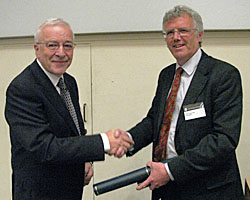 The medal named for William Smith celebrates outstanding achievement in the field of applied geology, and this year we are delighted to present it to Professor Tony Doré OBE, of Statoil.
During a distinguished career, Tony Doré has addressed a variety of geological topics. He combined current academic research with the wealth of offshore data becoming increasingly available to industry during the 1980s and 1990s, to create a series of tectonic-palaeogeographic syntheses of the North Atlantic-Arctic region. These are widely referred-to as a basis for exploration, research, and as a source of testable postulates – for example, the key role of reactivated basement structures during the evolution of the Atlantic-Arctic Rift.
The medal named for William Smith celebrates outstanding achievement in the field of applied geology, and this year we are delighted to present it to Professor Tony Doré OBE, of Statoil.
During a distinguished career, Tony Doré has addressed a variety of geological topics. He combined current academic research with the wealth of offshore data becoming increasingly available to industry during the 1980s and 1990s, to create a series of tectonic-palaeogeographic syntheses of the North Atlantic-Arctic region. These are widely referred-to as a basis for exploration, research, and as a source of testable postulates – for example, the key role of reactivated basement structures during the evolution of the Atlantic-Arctic Rift.
A continuing thread of his research has been the development of Cenozoic compression-inversion structures on the North Atlantic margin. Although a passive margin like many others, post-breakup compressional deformation seems to be a global paradigm, and the resulting structures important exploration targets. Tony, and colleague Erik Lundin, have documented the timing and geometry of such structures on the North Atlantic margin and shown how pre-existing structure is implicated. He and others have lately extended this approach to the relationship between hyper-extension and mantle serpentinisation, leading to a new paradigm for Atlantic margins, with worldwide potential.
Tony has been a key figure in researching passive margin uplift and exhumation – for example, the enigmatic late development of highlands around the North Atlantic, and the potentially radical effect that exhumation of marginal basins may have on hydrocarbon potential. This work is of exceptional economic importance to the UK and other countries bordering the region.
Tony Doré, you have been phenomenally active, forging links between industry and academia through your writing, editing, organising and collaborating over the past 25 years - and it is my great pleasure to award you the William Smith Medal of The Geological Society of London.
Tony Doré replied:
This award is the high point of my career to date, made all the more wonderful by receiving it on the bicentenary of William Smith’s great map. While I realize that the timing was just the luck of the draw, I’m sure you’ll understand what a great buzz this is for a regional geologist, since Smith was not only the father of English geology, but arguably the father of regional geology too.
On first reading, the citation you just heard seemed almost unreal, as if written about somebody else. But yes - I guess I did do all that stuff, albeit with a lot of help and encouragement from others. Make no mistake about it – trying to keep a foothold in academia and participate in the wider geoscience community, while holding down a series of very demanding jobs in the oil industry, is not easy. There was seldom any time for extracurricular activity, so writing scientific papers in what is laughably termed my “spare time” required a real love of the science, not to mention a certain dogged persistence. It also required a lot of tolerance on the part of others, for which I will always be grateful. Luckily, the two companies under whose umbrellas I did this work, Conoco and Statoil, showed a quite visionary attitude. They knew my interests motivated me in my day job, and they gained some significant fringe benefits, too. My wife Barbara, herself a natural scientist by training, knows that I am never happier than when I have my teeth into a geological project. She is extraordinarily tolerant, and a constant source of inspiration.
I am so glad that my long-term sparring partner, Erik Lundin, is acknowledged in the citation. Almost all of the ideas I am associated with were jointly evolved with Erik, often over a glass of beer and a plate of chili beef. I hope you will not mind if I jointly dedicate this award to him. If there is a Swedish equivalent of the William Smith Medal, he should be first in line! Health permitting, we have no intention of letting up, with our current attention turning to volcanic margins, transform margins and Arctic geology.
It’s customary at awards ceremonies to thank your mum and dad, and I am definitely not going to buck the trend. Without those hiking trips in Derbyshire, where I picked up my first fossils and minerals – and without my parents’ encouragement as they sensed the stirring of interest – I would never have started down this rewarding path. But on this occasion I want most of all to thank the Society, my proposers and supporters for this great and unexpected honour, and for a medal I will treasure forever.
Geoffrey Wadge (Murchison Medal)
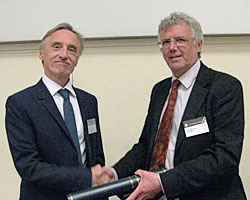 Sir Roderick Impey Murchison was one of the 19th Century’s most widely travelled Earth scientists; so it is perhaps appropriate that we award this year’s Murchison Medal to the widely travelled volcanologist, Professor Geoffrey Wadge of Reading University.
Sir Roderick Impey Murchison was one of the 19th Century’s most widely travelled Earth scientists; so it is perhaps appropriate that we award this year’s Murchison Medal to the widely travelled volcanologist, Professor Geoffrey Wadge of Reading University.
Geoffrey Wadge has made major contributions in a number of areas of geology and remote sensing. His 115 or so highly cited publications include volcanology, the tectonics of the Caribbean and the use of remote sensing in a number of geological scenarios, including novel ways of monitoring volcanoes.
His early reputation was made through his work on Etna, quantifying magma productivity, and relating it to basic hydraulic principles. He pioneered the development of cumulative curves of magma production, performing careful analysis of lava volumes, especially on Etna. He then linked these data with ideas on the pressure controls from magma chambers.
During his time at the University of the West Indies, Geoff made significant progress elucidating the tectonics of the Lesser Antilles Island Arc. He defined tectonic stresses through the systematic study of dykes, and was a major player in developing the currently accepted tectonic model for the Arc.
His Caribbean work included a highly perceptive 1988 hazard-assessment of the Soufrière Hills Volcano, Montserrat, in which he warned of the possibility of an eruption in the late 1990s, identified its likely impact and made recommendations on the island’s development (which were never acted upon).
This led to his becoming a key adviser when the eruption began in 1995, and to his undertaking important new research into this type of eruption, involving lava-dome growth, deformation and collapse. He has also been a leading innovator in the use of radar to monitor volcanoes, both from satellite and ground-based stations.
Geoff Wadge, you are a worthy recipient of the Murchison Medal of The Geological Society, which it is my great pleasure to present to you now.
Geoff Wadge replied:
Thank you for those kind words.
How did this happen? At Imperial I was beguiled by the remarkable George Walker, so volcanoes it was. My PhD topic was the deformation of Etna, to be measured with the prototype NPL mekometer. It required its maker to tweak 10 knobs simultaneously. This was at the top of Etna in November, and the outcome was predictably dire. I learnt belt-and-braces research, the braces being the estimation of the rate of magma erupted.
Teaching next, at the University of the West Indies in Jamaica; great fun in the era of Bob Marley, but hard to do research. Tom McGetchin at the Lunar and Planetary Institute in Houston threw me a lifeline – come and work on remote sensing of Caribbean plate tectonics. Following the revelation of interferometric radar in 1993, I joined the fray and later advocated, with Barry Parsons and others, bespoke radar space missions for volcanoes and earthquakes.
During the mid 1980s I worked at the Seismic Research Unit in Trinidad. One task was an assessment of volcanic hazards on Montserrat. The eventual eruption was the predicted disaster for Montserrat, but a huge boon for volcanology research, including mine.
Two long-term involvements have been particularly gratifying. Assessing the risks from the volcano and offering practical advice to the Montserrat government for over a decade with top-notch colleagues was a real privilege. And helping to nurture the remote sensing of earthquakes, tectonics and volcanoes into a world-class community via COMET has been wonderful.
The University of Reading has been home for 30 years, currently in the Department of Meteorology. It has kept me on my toes, pretending to understand matters meteoric.
I am very grateful to the Society for this honour and very pleased that my wife Linda can hear me say - thank you.
Colin Ballantyne (Lyell Medal)
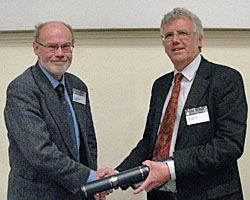 The medal named for one of the 19th Century’s most influential geologists, Sir Charles Lyell, goes this year to Professor Colin Ballantyne of the University of St Andrews.
The medal named for one of the 19th Century’s most influential geologists, Sir Charles Lyell, goes this year to Professor Colin Ballantyne of the University of St Andrews.
Colin Ballantyne is, arguably, Britain’s greatest living field geomorphologist. Firmly based on meticulous and painstaking fieldwork in many montane settings – not only here but in the Alps, New Zealand and North America - he has transformed our understanding of how periglacial processes operate in arctic and alpine environments, of the dimensions and palaeoclimatic implications of former glaciations, and of postglacial and paraglacial evolution in mountain landscapes. His work on former ice-sheets, especially their thickness (as derived by cosmogenic rock-exposure age-dating) has forced major revisions of our understanding of the growth and decay of Pleistocene ice sheets.
Early in Ballantyne’s career, the chronology for these geomorphic assemblages and events was provided by radio-carbon dating. He quickly saw the potential of cosmogenic rock-exposure age-dating to constrain landscape evolution, and established fruitful collaborations with pioneering groups who were developing the technique. In a series of seminal papers, he established deglaciation chronologies which constrain the timing and rate of ice-sheet decay from most of the mountain groups in Britain and Ireland.
Meticulous fieldwork characterises his work, as borne out by the integrity with which he revised his original chronologies (in 2010) to a different model - abandoning the idea that upland summit blockfields represented former nunataks, exposed above the ice surface. This has had profound implications for the way we understand the dynamics of how the British-Irish ice-sheet waned and vanished.
His work on upland periglaciation and the paraglacial modification of landscape has found direct application, and he is co-author of the influential textbook The Periglaciation of Great Britain (1994).
Colin Ballantyne, you are the leading field-based geomorphologist of our era, and it is my great pleasure to award you the Lyell Medal of The Geological Society of London.
Colin Ballantyne replied:
Thank you, Mr President. I am deeply honoured by this recognition of my research contribution by the Geological Society.
Charles Lyell was a fellow Scot by reason of his birth and family estates at Kinnordy in Angus. There is, however, some irony in the award of the Lyell Medal to someone who has promoted the understanding of Pleistocene glaciation. In 1840 Lyell presented papers to the Geological Society supporting the revolutionary idea of glaciation in Scotland, but in the face of acrimonious opposition from members of the society soon withdrew these, recanted his heresy and placed his faith in the effects of floating icebergs, a view that he maintained until his death in 1875 despite the burgeoning evidence to the contrary.
I have been fortunate in mentors, opportunities and collaborators. Of my collaborators, two deserve special a mention: Professor Doug Benn, one of the the most outstanding glaciologists of his generation; and Professor John Stone, of the University of Washington, a brilliant proponent of the use of cosmogenic isotopes in Earth Science. Without the stimulus, criticism and encouragement of these and many others, my research achievements would not be celebrated here today.
This is a time of accelerating change in geomorphology and Quaternary science, fuelled by technological and analytical advances. We can peer on to flooded continental shelves to trace the extent and retreat of ice sheets; we can use isotopes from ice cores to establish the timing of ice sheet growth and demise; we can determine rates of glacial abrasion, reconstruct the extent and history of former permafrost and model the ways in which landscapes have adjusted to postglacial conditions. I am privileged to have contributed to such developments, and gratefully accept this award on behalf not only of myself, but also of the scientific community that has made such exciting advances possible.
James Jackson (Wollaston Medal)
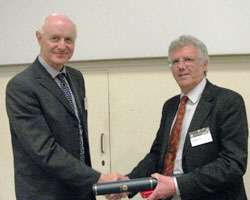 Finally, we come to the Wollaston Medal – the Society’s senior medal and highest accolade, first awarded to William Smith in 1831. Today this most prestigious accolade goes to Professor James Jackson of the University of Cambridge.
Finally, we come to the Wollaston Medal – the Society’s senior medal and highest accolade, first awarded to William Smith in 1831. Today this most prestigious accolade goes to Professor James Jackson of the University of Cambridge.
There is no region in the world where active continental deformation is taking place, of which our understanding has not been enhanced by some important contribution made by this year’s laureate. In a fashion rare in the modern world, James Jackson’s research spans a wide range of disciplines within geology, and his research is valued equally highly by academic and applied scientists. By his teaching and public communication, he has also been responsible for inspiring a generation of geologists and members of the wider public.
Very few scientists today are able to span the full range of disciplines involved in the study of tectonics; but of those who can and do, James Jackson stands at the forefront. Throughout his career he has seamlessly combined geology, geomorphology, geochronology and seismology to illuminate active tectonics in practically every major region of active continental deformation.
The way he is able to integrate these many disciplines at a profound level has led him to make ground-breaking syntheses of the Aegean region and Iran, and to many novel insights into the tectonics of western North America, the Middle East, Africa, New Zealand and Central Asia.
He has also made important contributions to our understanding of how the mechanics of the lower crust and upper mantle influence the tectonics seen in the upper crust, combining seismology, geodesy, metamorphic petrology and gravity in a way that is almost unique today.
In this sense, James is a 19th Century throwback! Not only does he (like Lyell, or Oldham) make no distinction between geology, geophysics or geochemistry - regarding all as equal servants in the cause of understanding our planet. He also draws no distinction between basic science and its application. His research has proved equally relevant to those interested in geodynamics, resource distribution on the continents, or in earthquake hazard and risk, and he goes to great lengths to ensure that the information he generates is accessible to all.
This alone would, perhaps be enough, but Jackson has also proved himself an outstanding educator. His memorable Christmas Lectures to Young People at the Royal Institution in 1995 drew many – young and old - into geology, and he continues to do whatever he can to enhance the public understanding and appreciation of science. An inspiring mentor, outstanding lecturer, his accomplishments are attested to by all his former students, who currently adorn both basic and applied aspects of our discipline.
James Jackson, you are a profoundly important figure in geoscience today. It therefore gives me the greatest pleasure to acknowledge your outstanding achievements by conferring upon you now the Wollaston Medal of The Geological Society of London.
James Jackson replied:
Thank you Mr President for this overwhelming honour, and thank you also to the Society, Council and those who nominated me.
I am here today through the chance of good luck and favourable timing. When I went to university I had no plans to become a geologist but was, like many, captivated on my first field trip (to Arran) by exposure to how detailed observations in the field can be connected to huge, planet-wide concepts and processes, and the vastness of geological time. The beauty of our subject, and particularly its ability to find simple explanations for what we see around us, hit me quite unexpectedly and very hard, and has stayed with me ever since. Later on I experienced a similar sense of wonder reading works by Arthur Holmes, Charles Cotton, Bob Wallace and John Ramsay, all of whom could instinctively see amazing things in the landscape and rocks, and who have inspired me throughout my career.
Then I just happened to graduate at a time when earthquake seismology developed rapidly, acquiring a sensitivity and accuracy that made it relevant in problems of structural and tectonic geology on the continents, so we could start to observe the processes those people talked about while they were actually going on today. Things only got better, with ever-increasing power and capability through satellite imagery, GPS, and radar interferometry. My colleagues and I soaked up these technological advances as they came along but, in spite of their intrinsic seductiveness, it was always their ability to help explain puzzles in the field that was their attraction to me. Most of the problems I have worked on had their origin in basic geological observations, and I can only imagine how jealous my earlier heroes would be, seeing the tools at our disposal now ─ while I still wonder at the insights they had without any of them. It is nonetheless quite clear that they foresaw what is now self-evident: that in the great continental earthquake belts signals in the landscape, or geomorphology, reveal the structural and tectonic geology in action; if only we can learn to read them properly.
So I have been lucky in timing, but also extremely fortunate with my colleagues: in particular, the opportunity to interact closely throughout my career with Dan McKenzie, Peter Molnar, Nick Ambraseys and Philip England has been an enormously privileged experience of mixing with giants, who time and again have stopped me making serious mistakes. In addition, I have worked with a stream of outstanding graduate students, who quickly became friends, colleagues and equals, and whose ability has often astounded me. And on top of all that, I have had the luck to be in a Department of Earth Sciences that instinctively works across disciplinary boundaries, is anti-hierarchical, and is full of people who want to give students the same inspiration, opportunities and excitement that have nurtured me. All these colleagues know how important they have been to me, and on their behalf, and in tribute to them, I accept this award with gratitude.